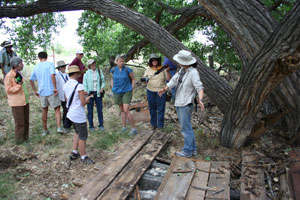Interested in environmental history? Here are some avenues for you...
Undergraduate Courses
History 311--History of Epidemics
In the 14th century, an infectious disease that came to be known as the Black Death emerged in Asia and spread along trade routes to Europe, killing an estimated 60% of the population in about a year. Using the Black Death as a starting point, this course will examine the history of epidemics across the globe from 1350 to the present day using case studies. We will spend a significant amount of the course analyzing primary sources from those who witnessed epidemics, treated the sick, and lived and died during various epidemic outbreaks and attempted to understand them from a range of personal, literary, film, medical, media, museum, and public health perspectives. We will analyze how epidemic and infectious diseases created historical watersheds that have shaped our world history socially, politically, environmentally, and economically to the present day. We will also examine human responses to epidemics in artistic, cultural, and intellectual realms, and the ways in which politicians, medical doctors, national and international bureaucracies, religious personnel, scholars, and everyday women and men debated their philosophical and moral implications.
History 355-- U.S. Environmental History
This lecture/discussion course explores the environmental history of the United States. We look at human interactions with the American environment through time--from the biotic changes set in motion by Columbus' arrival, to 19th-century technological and industrial transformations of nature, to Wise Use and EarthFirst! environmentalism of the late 20th century. Along the way, we delve into particular topics, considering throughout how different cultural groups experience and represent nature and how the environment itself shapes our history. We examine changing attitudes about nature and natural resources, and explore the relation between present day environmental issues and the past
This lecture/discussion course explores the environmental history of the United States. We look at human interactions with the American environment through time--from the biotic changes set in motion by Columbus' arrival, to 19th-century technological and industrial transformations of nature, to Wise Use and EarthFirst! environmentalism of the late 20th century. Along the way, we delve into particular topics, considering throughout how different cultural groups experience and represent nature and how the environment itself shapes our history. We examine changing attitudes about nature and natural resources, and explore the relation between present day environmental issues and the past
History 356-- Global Environmental History
This course examines the ways in which different societies have defined, understood, valued, mapped, and made their livings in their environment. Also, it explores how societies and environments mutually transform one another.
History 358-- The Natural History of Disasters
In this course we’ll be considering a range of natural disasters from a historical perspective. Earthquakes, storms, floods, fires, pandemics, and droughts have all disrupted and transformed lives, environments, and societies. What defines a “natural” disaster? How have individuals, groups and nations understood and responded to these events? How have ideas about natural disasters changed over time? What are human responsibilities for natural disasters? What do historians have to offer in thinking about natural disasters today? Taking an environmental history approach, this course offers broadly based coverage of major topics in disaster studies, including cultural and political responses; disaster narratives and representations; changing scientific, technological and cultural interpretations of nature; memory and remembrances; impact of disasters on policy, economy, planning and society. We will explore and compare case studies through time and space, with an emphasis on natural disasters in American history. Throughout we will examine disasters as social, cultural and environmental phenomena, develop skills in analysis and interpretation, and consider the changing meanings of disasters.
Keep your eyes out for our environmental history field course, traditionally offered in May.
University of Arizona Resources
- BioSphere2
- UA Herbarium
- Students for Sustainability
- UA/NASA Space Grant: Undergraduate Internship Program

Other Resources
- American Environmental Photographs, 1891-1936 Library of Congress, American Memory
- American Society for Environmental History
- Canyons, Cultures and Environmental Change: An Introduction to the Land Use History of the Colorado Plateau
- Learning to do Historical Research: A Primer for Environmental Historians and Others A great website created by William Cronon and graduate students at the University of Wisconsin-Madison
- Nature Transformed, The Environment in American History, National Humanities Center
- NICHE--Network in Canadian History & Environment
